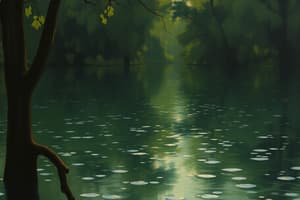Podcast
Questions and Answers
What is film primarily a medium for?
What is film primarily a medium for?
- Literature
- Fashion design
- Scientific research
- Mass communication (correct)
The term 'film' refers only to the movie itself and not the technology behind it.
The term 'film' refers only to the movie itself and not the technology behind it.
False (B)
What was the original purpose of the inventors and artists experimenting with film technology?
What was the original purpose of the inventors and artists experimenting with film technology?
To capture snippets of reality.
A film is the end product of a __________ process.
A film is the end product of a __________ process.
Match the following key terms related to film:
Match the following key terms related to film:
Which phrase best captures the essence of film according to the text?
Which phrase best captures the essence of film according to the text?
The creation of film was a deliberate and well-planned process.
The creation of film was a deliberate and well-planned process.
What does film sit at the intersection of?
What does film sit at the intersection of?
What phenomenon prevents us from seeing the black spaces between frames in a film?
What phenomenon prevents us from seeing the black spaces between frames in a film?
The Phi Phenomenon was first defined by a British scholar.
The Phi Phenomenon was first defined by a British scholar.
What is the minimum frame rate mentioned to create the illusion of motion in films?
What is the minimum frame rate mentioned to create the illusion of motion in films?
The original film technology has switched to ______ substitutes like VHS, Beta, and digital video.
The original film technology has switched to ______ substitutes like VHS, Beta, and digital video.
Match the following terms with their descriptions:
Match the following terms with their descriptions:
Who is credited with first describing the Persistence of Vision?
Who is credited with first describing the Persistence of Vision?
The initial form of film consisted of moving pictures.
The initial form of film consisted of moving pictures.
What early cave paintings are thought to be a form of animation?
What early cave paintings are thought to be a form of animation?
The illusion of motion can be seen in a ______ book that flips images rapidly.
The illusion of motion can be seen in a ______ book that flips images rapidly.
In the context of film, what does a 'frame' refer to?
In the context of film, what does a 'frame' refer to?
Flashcards are hidden until you start studying
Study Notes
Introduction to Film
- Film is a universal language that conveys collective hopes and fears, helping to understand the world and people.
- It intersects art, industry, technology, and politics, deeply embedded in human culture.
- Film has evolved from early experiments with technology aimed at capturing reality.
Definition of Film
- "Film" originally referred to a thin, flexible material with light-sensitive emulsion that captures images.
- It can denote the end product (a movie) or the act of capturing moving pictures.
- The technology has transitioned from analog formats like VHS to digital video formats, including mobile recordings.
Origins of Film
- Early films were a series of still images shown rapidly to create the illusion of motion; akin to a magic trick.
- The art form combines elements of literature, drama, photography, and music.
Key Perception Theories
- Persistence of Vision: Describes how the human brain retains an image for a short period, creating the illusion of continuous motion when frames are viewed rapidly.
- Phi Phenomenon: An optical illusion where a series of images in rapid succession are perceived as smooth motion, similar to the use of flip books.
Historical Context of Storytelling
- Storytelling is an ancient practice, dating back to the origins of human language.
- The tradition of combining pictures and storytelling can be traced back to cave paintings from 32,000 years ago, which may have utilized flickering torchlight to animate the images.
Studying That Suits You
Use AI to generate personalized quizzes and flashcards to suit your learning preferences.




